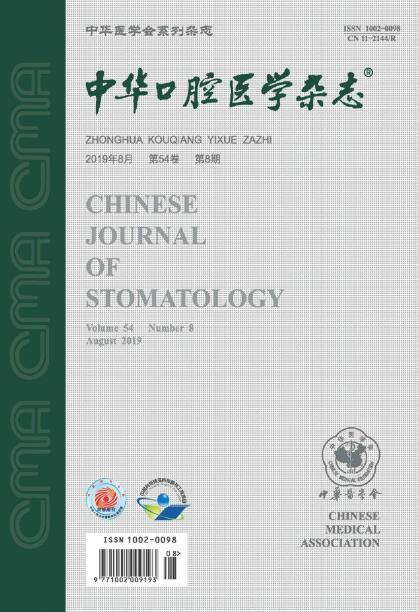[不同配准方法对多牙缺失种植体修复虚拟咬合记录准确性的影响:一项体外研究]。
摘要
目的研究口内扫描虚拟咬合记录(VOR)中四种登记方法对多颗缺失牙种植修复准确性的影响。方法:模拟临床情况的下颌模型:将一个模拟多颗缺失牙(右第一臼齿、左第二前臼齿、左第一臼齿、左第二臼齿)临床情况的下颌模型和一个上颌竞争牙模型安装在一个半可调铰接器上。随后,在参考位置(16、46、13、43、23、33、25、35、26、36、27、37)粘贴了 12 个 0.5 毫米的不锈钢球作为靶标。随后,实验室扫描仪通过对模型进行最大夹角(MIP)数字化,生成参考数据集。同时,使用口内扫描仪采集了十张上颌和下颌扫描图像,所有非关节扫描图像均重复四次,以确保数据的一致性。在 MIP 中使用四种配准方案进行了 40 次 VOR 口内扫描:左侧、右侧、前方和双侧配准(每组 10 人),通过计算机生成的伪随机序列进行随机化。测量时,使用逆向工程软件测量对侧标记物之间的线性距离(D16-46、D13-43、D23-33、D25-35、D26-36、D27-37、D16-46 代表单齿缺损位置,而 D25-35、D26-36、D27-37 反映自由端缺损区域的位置),计算与参考扫描的偏差(ΔD)以评估准确性。具体来说,负ΔD 值表示垂直维度估计不足。鉴于非正态分布数据采用中位数[四分位数间距 (IQR)]进行分析,因此对真实度(中位数 ΔD)和精确度(IQR)进行了评估。使用广义线性模型评估了配准方法和测量项目位置之间的交互效应。准确度的整体比较采用 Kruskal-Wallis 检验,双侧显著性水平为 α=0.05。对于成对比较,采用 Dunn's t 检验进行事后检验,显著性水平采用 Bonferroni 校正。结果VOR 的准确性受配准方法的影响,位置与配准方法之间存在显著的交互作用(P0.05)。其中,在所有四组中,只有双侧配准组的自由端缺牙和单牙缺损的真实度小于 0.1 mm,ΔD16-46、ΔD25-35、ΔD26-36 和 ΔD27-37 分别为 0.059 (0.015)、-0.082 (0.052)、-0.065 (0.032)、-0.070 (0.050) mm。此外,在所有组别中,自由端缺牙的真实度均为负值,其中右侧登记组的负偏差最大,ΔD16-46、ΔD25-35 和 ΔD26-36 分别为 -0.410 (0.174)、-0.442 (0.225)、-0.439 (0.262) mm。结论在全数字化工作流程中,下颌自由端缺牙和多颗牙齿缺失的种植修复中,配准方法对 VOR 的准确性有至关重要的影响。虽然四种配准方法都低估了咬合垂直度,但双侧配准的准确度最高。Objective: To investigate the impact of four registration methods on the accuracy of virtual occlusal records (VOR) in intraoral scanning for implant restorations with multiple missing teeth. Methods: A mandibular model simulating clinical conditions with multiple missing teeth (right first molar, left second premolar, left first molar, left second molar) and a maxillary compete dentition model were mounted on a semi-adjustable articulator. Subsequently, twelve 0.5 mm stainless steel spheres were adhered to reference positions (16, 46, 13, 43, 23, 33, 25, 35, 26, 36, 27, 37) as fiducial markers. Following this, a laboratory scanner generated reference datasets by digitizing the models in maximum intercuspation (MIP). Meanwhile, ten maxillary and mandibular scans were acquired using an intraoral scanner, with all nonarticulated scans duplicated four times to ensure data consistency. Forty VOR intraoral scans were performed in MIP using four registration protocols: left-side, right-side, anterior, and bilateral registration (n=10 per group), randomized via a computer-generated pseudo-random sequence. For measurement, linear distances (D16-46, D13-43, D23-33, D25-35, D26-36, D27-37, D16-46 represented the single-tooth defect position, whereas D25-35, D26-36, D27-37 reflected positions in free-end edentulism areas) between opposing markers were measured in a reverse engineering software, with deviations (ΔD) from the reference scan calculated to assess accuracy. Specifically, negative ΔD values indicated vertical dimension underestimation. Given that non-normally distributed data were analyzed using medians [interquartile ranges (IQR)], trueness (median ΔD) and precision (IQR) were evaluated. The interaction effect between the registration method and the position of the measurement items was evaluated by using the generalized linear model. The accuracy was compared overall by the Kruskal-Wallis test with the two-sided significance level of α=0.05. For pairwise comparisons, post-hoc tests were conducted by Dunn's t-test with the Bonferroni correction for the significance level. Results: The accuracy of VOR was affected by registration method (P<0.05), with a significant position×registration method interaction observed (P<0.05). In particular, in all four groups, only the bilateral registration group showed trueness of less than 0.1 mm for both free-end edentulism and the single tooth defect, with ΔD16-46, ΔD25-35, ΔD26-36, and ΔD27-37 being 0.059 (0.015), -0.082 (0.052), -0.065 (0.032), -0.070 (0.050) mm, respectively. Moreover, trueness in free-end edentulism showed negative values across all groups, with the largest negative deviations observed in the right-side registration group, with ΔD25-35, ΔD26-36 and ΔD27-37 being -0.410 (0.174), -0.442 (0.225), -0.439 (0.262) mm, respectively. Conclusions: In fully digital workflows of implant restorations for mandibular free-end edentulism with multiple missing teeth, registration method critically influences VOR accuracy. While four registration methods exhibited underestimation of occlusal vertical dimension, bilateral registration achieved the highest accuracy.

 求助内容:
求助内容: 应助结果提醒方式:
应助结果提醒方式:


